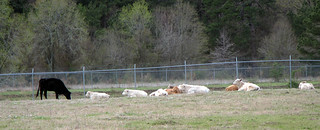April – Time to get ready to breed spring-calving beef heifers
Separate heifers from mature cows because heifers cannot compete with mature cows for the better quality forage in the pasture. (UAPB Image)
PINE BLUFF, Ark. – April is the time for ranchers to think about the upcoming breeding season. Most cattle producers breed their cows in June so they will calve in March and April, but heifers should be bred 20 to 30 days before the rest of the herd.
“That means breeding season is only a month away,” says Dr. David Fernandez, Cooperative Extension Program livestock specialist at the University of Arkansas at Pine Bluff.
Vaccinate heifers for IBR-BVD-P13, PRSV, vibriosis, leptospirosis and blackleg 7-way 30 to 60 days before breeding them. This helps ensure that heifers will be healthy during their pregnancy, and abortions, due to preventable diseases, will be reduced, says Dr. Fernandez.
Be sure heifers are in good condition before breeding them. If they are too thin, especially after a hard winter, they are less likely to reach puberty or become pregnant. Separate heifers from mature cows. Heifers cannot compete with mature cows at the feed bunk or for the better quality forage in the pasture. Feed heifers to reach about 65 percent of their mature weight at breeding.
Avoid overfeeding heifers. Overconditioned ones deposit fat in the udder, which reduces milk production later. They also have more calving difficulty and are more difficult to rebreed.
Choose heifers carefully. Select them based on adjusted 205-day weaning weight, birth weight, structural correctness, frame size or hip height and good health history. High weaning/low birth weight heifers that are structurally sound, moderate-sized and healthy are the ones to breed, advises Dr. Fernandez.
Because heifers have more trouble calving than mature cows, plan for your heifers to produce smaller, easier calves with good growth potential. Some producers use young bulls on heifers to try to reduce calf birth weights, but young bulls do not produce smaller calves than mature bulls. Instead, Dr. Fernandez suggests using a low birth weight epd bull or a calving ease bull with your heifers.
Breed heifers for 45 days and then check them for pregnancy at 60 to 90 days. Cull open heifers. Feed heifers to gain about .8 to 1 lb. per day until calving. Some producers underfeed pregnant heifers in an attempt to reduce calf birth weights. But, underfed, thin heifers experience more calving problems, poor milk production, weak calves and failure to breed back.
Heifers should be in good body condition next year when they calve (a body condition score of 5 or 6 on a scale of 1=emaciated to 9=obese), says Dr. Fernandez. Even when they calve in good condition, 2 year olds take 20 to 30 days longer than mature cows to breed back after their first calf.
Preparation today will help reduce breeding problems and produce the best calves your heifers can produce next year, advises Dr. Fernandez. For more information, contact Dr. Fernandez at (870) 575-7214 or via email fernandezd@uapb.edu.
Carol Sanders, writer/editor
UAPB School of Agriculture, Fisheries and Human Sciences
(870) 575-7238
sandersc@uapb.edu
Related Links
